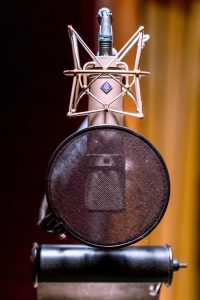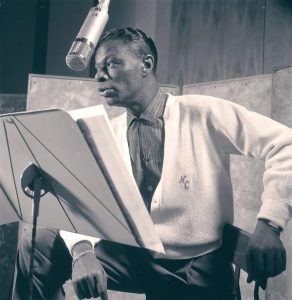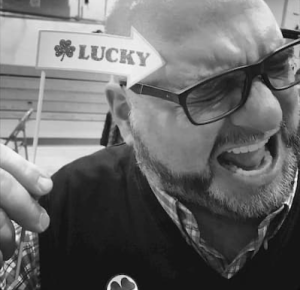Downside Up, Upside down! Why You Need to Flip the Mic.

By Frank Verderosa, September 24, 2023
One of the questions that comes up from time of time when consulting with voice actors is “why do some people have their mic upside down?”. You’ll see mics positioned this way in every professional recording studio you go to, and in the home setups of many voice actors. The answer to this question has both historical and practical signicance.
There was a period of time where tube microphones were common. The goal is to amplify the low signal from the mic capsule as close as possible to the source to keep the noise level low. Some tube powered microphones will even have their own power supply box that can rest at the foot of the mic stand, keeping the power close to the mic before running a longer cable to the mixer or preamp. The tubes inside the mic, however, heat up over time. So if you’re recording a vocalist during a long session, that warm air will cause the microphone’s diaphragm to expand- coloring the sound. The solution to this problem is simple! Hang the microphone upside down and let the heat rise away from the capsule. Tube microphones are still common today, especially in higher-end music studios. A great example of one is the Neumann U67. But Neumann developed a solid state alternative to their tube mics, and released the ubiquitous U87 as a tube-free version of the classic U67.

For voiceover work, tube microphones are rare and largely overkill. Most of the mics you’ll be using at home don’t have tubes: the U87, TLM 102, 103, Rode Nt1, Nt1A, Stellar X2, etc. So then why do so many studios and actors still opt for their mic to hang upside down?
There are several reasons:
For me, a big one is line of sight. When you’re properly positioned at your mic, and it’s upside down, you can glance slightly down or straight ahead at your copy without the entire mic and pop filter obstructing your view. But be careful! You don’t want to get too close to your music stand or your tablet/ computer display. Getting too close can cause reflections, which will give you some comb filtering- an unflattering artifact of your mic being too close to a reflective (or any) surface.
Another benefit is your breathing. If you’re doing most voice work for short form jobs, like commercials or promos, you want to be standing. If you’re lowering your chin by looking down, you’re effecting how you breath. With your head up, and your view clear, you can open your chest to breath more- and sound better.
Article continues below.
From the Society of Voice Arts and Sciences
Article continues…
Perhaps the most important reason for the mic being upside down is your sound quality. Very often when I consult with people on their sound, they’ll have their mic set up a decent height, but in an effort to see copy, they’ll come at the mic on an angle while they look to the left or right a bit to read copy. Even a twenty degree head turn can radically change your sound.- especially in smaller closets or booths. Speaking of height- you want to make sure you’re talking into the lower portion of the capsule, not into the body of the mic. This is a common mistake I see people make, causing people to lose some of the richness of your voice.
If your mic is upside down, and your nose is at the same height as the diaphragm, the air from your mouth is passing under the mic. This will usually give you far less (or zero) plosives! With the mic right-side up, you’re breathing down into the mic- especially if your copy is at or below the mic. Even with a pop-filter, you’re pushing air down onto the mic and getting plossives.
When your mic is upside down on a boom stand or desk arm, it gives you space underneath it for your copy. Very often, I’ll see people with their mic in a shockmount sitting atop a regular stand, with nowhere to place a tablet or music stand that won’t interfere with your sound. It can also be awkward trying to get close enough. Again, the end result is often turning away from the mic, which causes a decline in the sound quality. Distance to the mic is critical- especially in tight, home recording setups. More on that soon!
If you’re not sure about how your setup is sounding, I continue to offer 15 minute consults to get placement and levels sorted out. In that small amount of time, I’ve been able to make big changes for a lot of people.

Frank Verderosa is a proud audio nerd. It’s what he does. It’s pretty much all he’s ever done. After earning a Bachelor of Science degree in Sound Recording Technology at S.U.N.Y., Frank jumped right in, logging countless hours as an assistant engineer for producers like Hank Shocklee (Public Enemy, The Young Black Teenagers) and Ric Wake (Mariah Carey, Donny Osmond, Hall and Oates). After joining the team at Soundtrack NY, Frank was exposed to so much hip hop tracking and mixing that it drove him into the loving arms of the advertising world and post production mixing. He then hit the ground running with work for Bozell and Wieden and Kennedy’s Portland office. That led to some nice award-winning projects (most notably making the Communication Arts Annual with some radio spots produced for Barq’s Root Beer via Wieden). Frank calls himself a senior mixer. He’s modest. We call him a master audio designer. For more insightful articles by Frank, check him out at https://www.frankverderosa.com/
From the Society of Voice Arts and Sciences
The 2023 Voice Arts Awards Are Open For Entries CLICK TO ENTER














